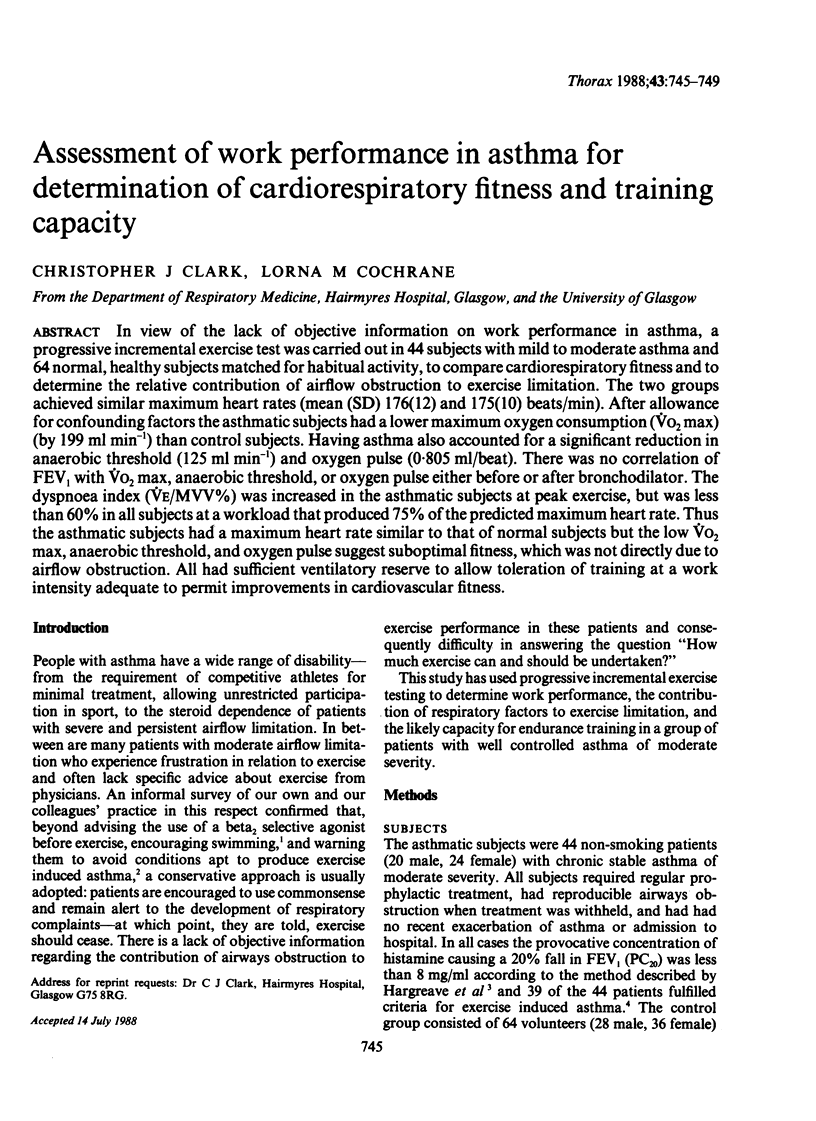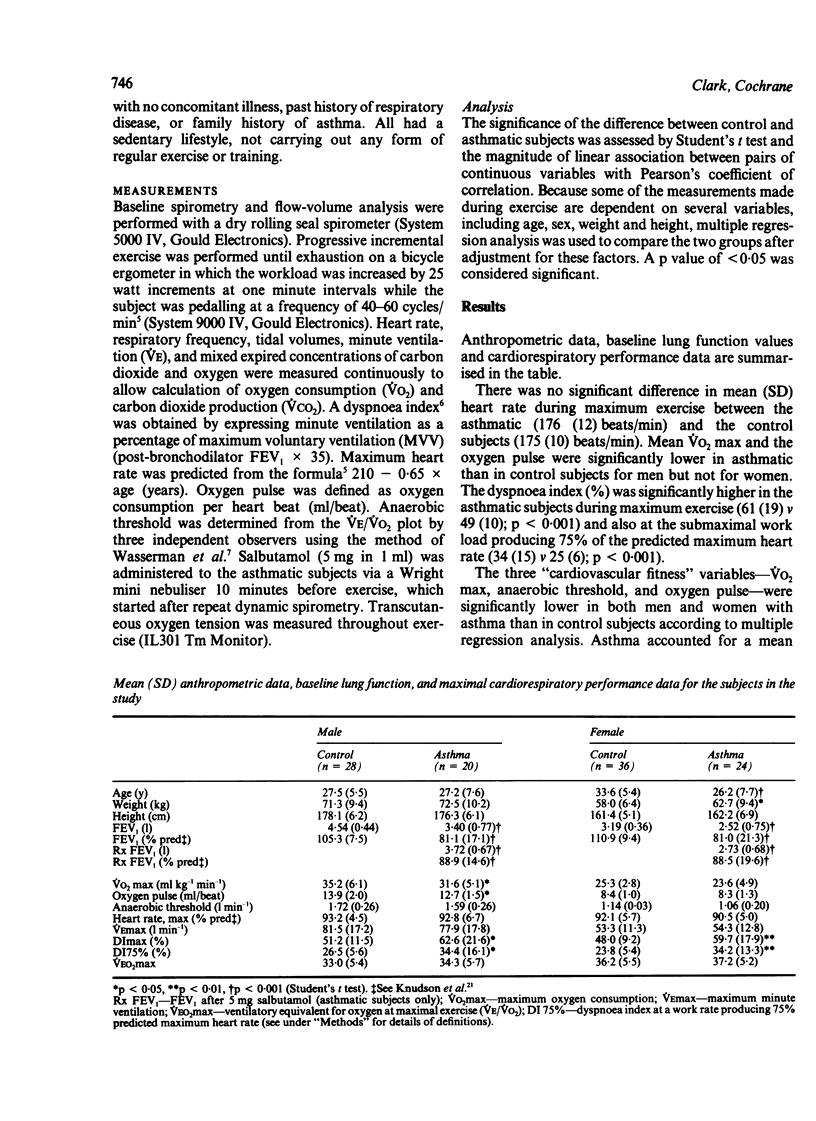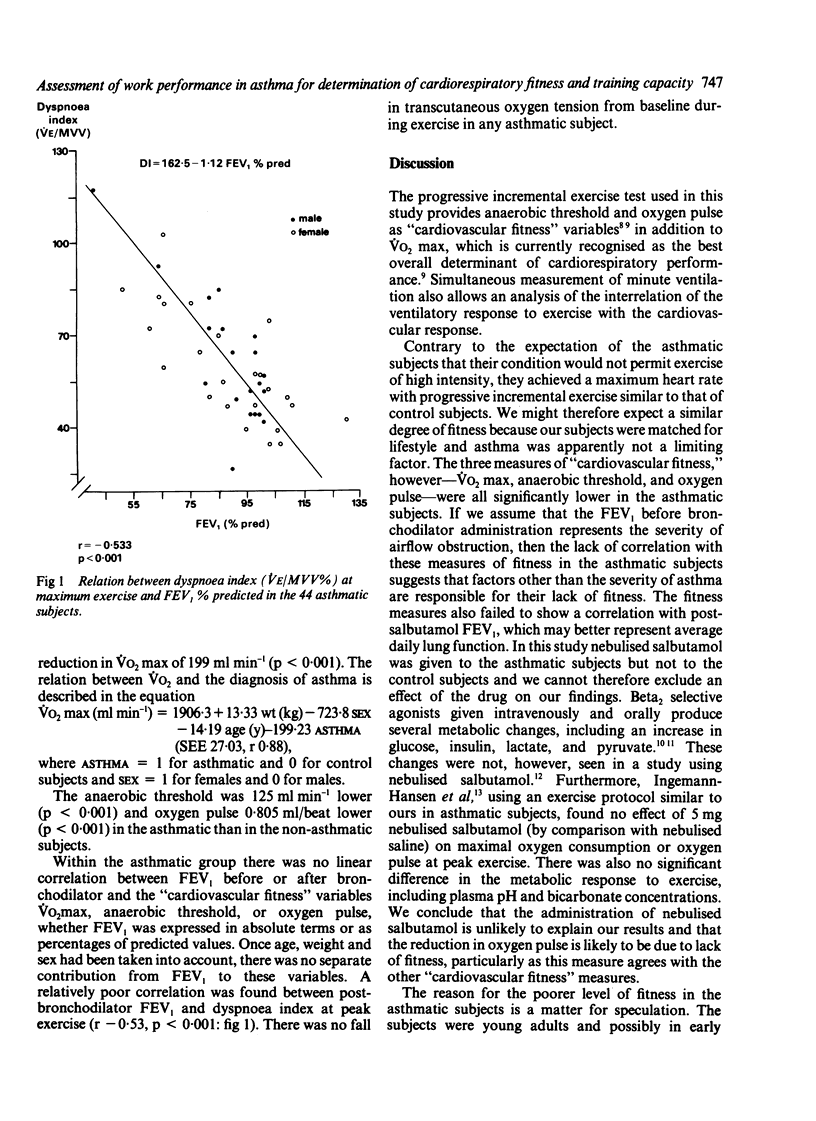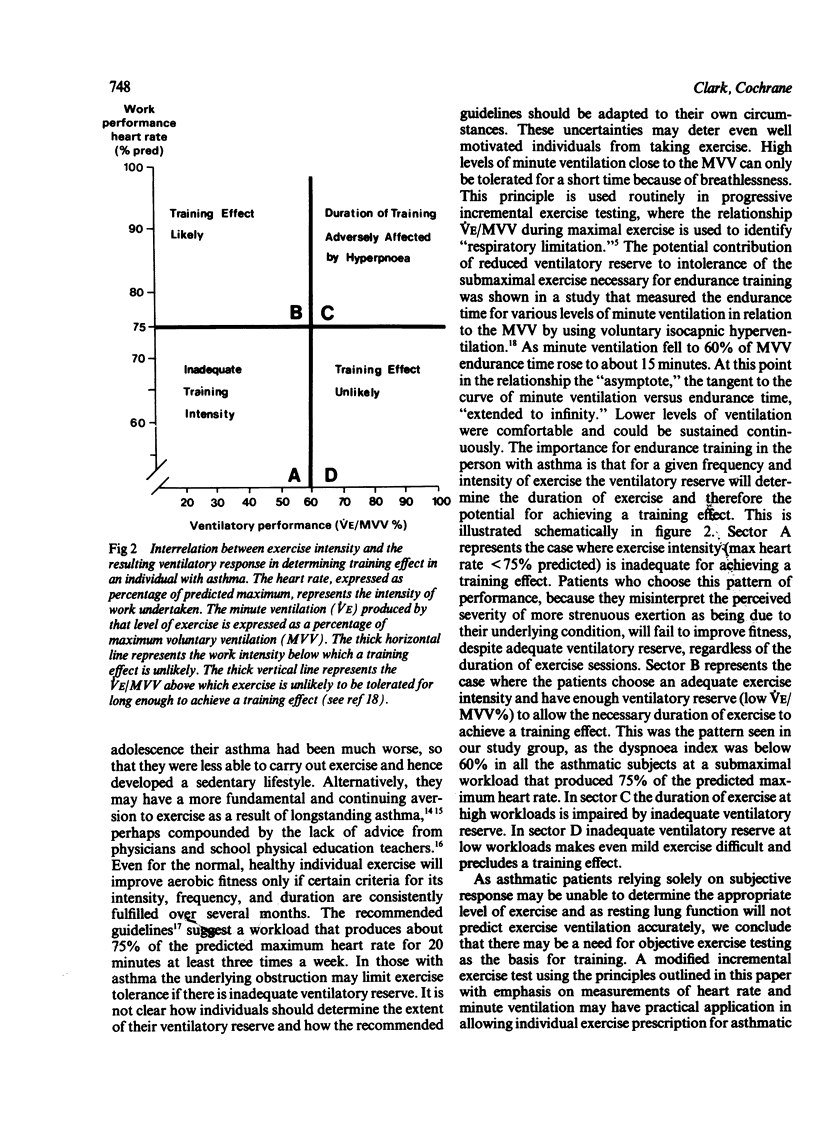Abstract
In view of the lack of objective information on work performance in asthma, a progressive incremental exercise test was carried out in 44 subjects with mild to moderate asthma and 64 normal, healthy subjects matched for habitual activity, to compare cardiorespiratory fitness and to determine the relative contribution of airflow obstruction to exercise limitation. The two groups achieved similar maximum heart rates (mean (SD) 176(12) and 175(10) beats/min). After allowance for confounding factors the asthmatic subjects had a lower maximum oxygen consumption (VO2 max) (by 199 ml min-1) than control subjects. Having asthma also accounted for a significant reduction in anaerobic threshold (125 ml min-1) and oxygen pulse (0.805 ml/beat). There was no correlation of FEV1 with VO2 max, anaerobic threshold, or oxygen pulse either before or after bronchodilator. The dyspnoea index (VE/MVV%) was increased in the asthmatic subjects at peak exercise, but was less than 60% in all subjects at a workload that produced 75% of the predicted maximum heart rate. Thus the asthmatic subjects had a maximum heart rate similar to that of normal subjects but the low VO2 max, anaerobic threshold, and oxygen pulse suggest suboptimal fitness, which was not directly due to airflow obstruction. All had sufficient ventilatory reserve to allow toleration of training at a work intensity adequate to permit improvements in cardiovascular fitness.
Full text
PDF




Selected References
These references are in PubMed. This may not be the complete list of references from this article.
- Bannister R. Sport, physical recreation, and the national health. Br Med J. 1972 Dec 23;4(5842):711–715. doi: 10.1136/bmj.4.5842.711. [DOI] [PMC free article] [PubMed] [Google Scholar]
- Bateman S. M., Pidgeon J., Spiro S. G., Johnson A. J. The metabolic effects of inhaled salbutamol. Br J Clin Pharmacol. 1978 Feb;5(2):127–129. doi: 10.1111/j.1365-2125.1978.tb01612.x. [DOI] [PMC free article] [PubMed] [Google Scholar]
- Davis J. A., Vodak P., Wilmore J. H., Vodak J., Kurtz P. Anaerobic threshold and maximal aerobic power for three modes of exercise. J Appl Physiol. 1976 Oct;41(4):544–550. doi: 10.1152/jappl.1976.41.4.544. [DOI] [PubMed] [Google Scholar]
- Fitch K. D., Morton A. R. Specificity of exercise in exercise-induced asthma. Br Med J. 1971 Dec 4;4(5787):577–581. doi: 10.1136/bmj.4.5787.577. [DOI] [PMC free article] [PubMed] [Google Scholar]
- Froelicher V. F., Oberman A. Analysis of epidemiologic studies of physical inactivity as risk factor for coronary artery disease. Prog Cardiovasc Dis. 1972 Jul-Aug;15(1):41–65. doi: 10.1016/0033-0620(72)90004-7. [DOI] [PubMed] [Google Scholar]
- Gaensler E. A., Wright G. W. Evaluation of respiratory impairment. Arch Environ Health. 1966 Feb;12(2):146–189. doi: 10.1080/00039896.1966.10664355. [DOI] [PubMed] [Google Scholar]
- Godfrey S. Exercise-induced asthma--clinical, physiological, and therapeutic implications. J Allergy Clin Immunol. 1975 Jul;56(1):1–17. doi: 10.1016/0091-6749(75)90029-9. [DOI] [PubMed] [Google Scholar]
- Goldberg R., van As M., Joffe B. I., Krut L., Bersohn I., Seftel H. C. Metabolic responses to selective beta-adrenergic stimulation in man. Postgrad Med J. 1975 Feb;51(592):53–58. doi: 10.1136/pgmj.51.592.53. [DOI] [PMC free article] [PubMed] [Google Scholar]
- Hargreave F. E., Ryan G., Thomson N. C., O'Byrne P. M., Latimer K., Juniper E. F., Dolovich J. Bronchial responsiveness to histamine or methacholine in asthma: measurement and clinical significance. J Allergy Clin Immunol. 1981 Nov;68(5):347–355. doi: 10.1016/0091-6749(81)90132-9. [DOI] [PubMed] [Google Scholar]
- Holgate S. T., Stubbs W. A., Wood P. J., McCaughey E. S., Alberti K. G., Tattersfield A. E. Airway and metabolic resistance to intravenous salbutamol: a study in normal man. Clin Sci (Lond) 1980 Sep;59(3):155–161. doi: 10.1042/cs0590155. [DOI] [PubMed] [Google Scholar]
- Ingemann-Hansen T., Bundgaard A., Halkjaer-Kristensen J., Siggaard-Andersen J., Weeke B. Maximal oxygen consumption rate in patients with bronchial asthma-the effect of beta 2-adrenoreceptor stimulation. Scand J Clin Lab Invest. 1980 Apr;40(2):99–104. doi: 10.3109/00365518009093010. [DOI] [PubMed] [Google Scholar]
- Knudson R. J., Slatin R. C., Lebowitz M. D., Burrows B. The maximal expiratory flow-volume curve. Normal standards, variability, and effects of age. Am Rev Respir Dis. 1976 May;113(5):587–600. doi: 10.1164/arrd.1976.113.5.587. [DOI] [PubMed] [Google Scholar]
- Leith D. E., Bradley M. Ventilatory muscle strength and endurance training. J Appl Physiol. 1976 Oct;41(4):508–516. doi: 10.1152/jappl.1976.41.4.508. [DOI] [PubMed] [Google Scholar]
- Orenstein D. M., Reed M. E., Grogan F. T., Jr, Crawford L. V. Exercise conditioning in children with asthma. J Pediatr. 1985 Apr;106(4):556–560. doi: 10.1016/s0022-3476(85)80071-8. [DOI] [PubMed] [Google Scholar]
- Sly R. M., Harper R. T., Rosselot I. The effect of physical conditioning upon asthmatic children. Ann Allergy. 1972 Feb;30(2):86–94. [PubMed] [Google Scholar]
- Verma S., Hyde J. S. Physical education programs and exercise-induced asthma. Individualized gym programs allow asthmatic youngsters to participate with great benefit. Clin Pediatr (Phila) 1976 Aug;15(8):697-9, 704-5. doi: 10.1177/000992287601500806. [DOI] [PubMed] [Google Scholar]


